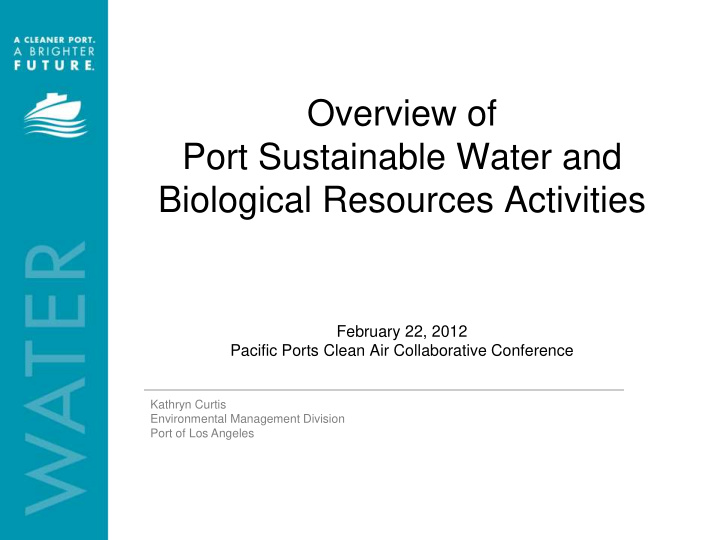



Overview of Port Sustainable Water and Biological Resources Activities February 22, 2012 Pacific Ports Clean Air Collaborative Conference Kathryn Curtis Environmental Management Division Port of Los Angeles
Water/Biological Resources Programs • Water Resources Action Plan • Clean Marina Program • Stormwater Management (NPDES) • Tenant Outreach Program • TMDLs • Cabrillo Beach Water Quality Improvement Study • Port-wide Sediment Management • Biological Resources Management
Dominguez Watershed
Harbor Water Quality Improvement
Water Resources Action Plan (WRAP)
Water Resources Action Plan • Comprehensive plan that integrated existing water and sediment management programs, and identified additional programs needed to improve water and sediment quality • Agency and stakeholder participation important • Control measures currently being implemented • Living document – to be updated as needed
WRAP Goal/Purpose • WRAP Goal Statement: – Support the attainment of full beneficial uses of harbor waters and sediments by addressing the impacts of past, present, and future Port operations – Prevent Port operations from degrading existing water and sediment quality • To take a proactive role in the development and implementation of Dominguez Watershed TMDLs (Total Maximum Daily Load) and upcoming NPDES (National Pollutant Discharge Elimination System) stormwater permits
Water Resources Action Plan Pollutant Source Categories Upstream Watershed Port Water-side • • Stormwater flows into harbor Vessel discharges • • Aerial deposition Vessel maintenance Port Land-side Sediment • • Tenant Operations Contaminated hot spots (Container Terminals, Boat • Resuspension Yards, etc.) Port Land Watershed Water Sediment
WRAP Control Measures Land Use On-Water LU-1: House Keeping BMPs OW-1: Vessel Guidance Manual LU-2: Design Guidance Manual OW-2: Piling Replacement Policy and Standards LU-3: Install Structural BMPs OW-3: BMPs and Standards for LU-4: Stormwater/Dust Cathodic Protection Control for Orphan Sites LU-5: Litter Control Program Sediment LU-6: Public Area Sweeping S-1: Operations Sediment Programs Management Plans S-2: Legacy/Hotspot Sediment LU-7: Port-Wide Stormwater Management Plans Construction Permit LU-8: Remote Sites Stormwater Watershed Compliance WS-1: Support Pollutant Loading Reduction Efforts
Clean Marina Program • Clean Marina Recognition Program • Education and Outreach • Sewage Management • Outboard Gasoline Engine Exchange Program • Derelict Recreational Vessel Program • Seaworthiness Assessment • Used Oil Recycling • In-Water Trash Management
Clean Marina Program • Marina/boater outreach and education • Clean Marina Program Guidebook • Water quality benefits • Vessel discharge restrictions • Vessel maintenance BMPs • Recycling facilities • Air quality benefits • Engine exchange program
Stormwater Management • Major water quality issue for the Ports • NPDES permit compliance activities • Tenant Outreach Program • Site visits and follow-up recommendations regarding house-keeping and structural Best Management Practices • Educational material • Permitting assistance • Tenant database
TMDL - Total Maximum Daily Load • Federal regulations to establish “load allocations” for contaminants of concern in identified impaired water bodies • Bacteria TMDL for Cabrillo Beach and Main Channel in POLA • TMDLs for metals and organic pollutants throughout POLA and POLB harbors • Impairments are for sediment/fish tissue exceedances, not ambient water quality, which means dredging to meet compliance
TMDL - Inner Cabrillo Beach • Protected swimming beach in outer harbor with high bacteria levels along the shoreline • Subject of major Port effort to address public health concerns and TMDL compliance • Multiple remedies have been implemented including sewer and storm drain repairs, beach sand replacement, bird exclusion structure, groin removal – but levels still high • Additional circulation enhancement pilot studies underway
TMDL - Sediment Management • TMDLs for sediment impairments (legacy contamination) in harbors • Monitoring to identify sediment “hot spots” • Identify responsible parties/stakeholders • Identify remediation and disposal options • Manage remediation activities in conjunction with Port dredging projects where possible • Sediment Management Guidance document
Biological Resources Management • CA Least tern site management at POLA • Important aquatic habitats • Eelgrass • Kelp • Salt marsh • Shallow water habitat • Habitat restoration/mitigation • In harbor • Off site • Periodic comprehensive Biological Baseline Surveys
CA Least Tern Management • POLA has an agreement with resource agencies that governs the provision and maintenance of a California Least Tern nesting site in the harbor • Site preparation and monitoring during nesting season
Harbor Habitats Shallow Water Habitat Tern Nesting Site Eelgrass Salt Marsh Kelp
Bolsa Chica Wetland Before and After Restoration 305 Biological Mitigation Credits to each Port
Batiquitos Lagoon Before and After Restoration 381 Biological Mitigation Credits
Biological Baseline Surveys • Joint surveys of San Pedro Bay conducted by the two Ports in 2000 • Results indicate and 2008 high biological productivity in harbor • Will perform on a regular (5- year) basis in conjunction with a larger regional sampling effort to update information and monitor trends
Questions?
Recommend
More recommend